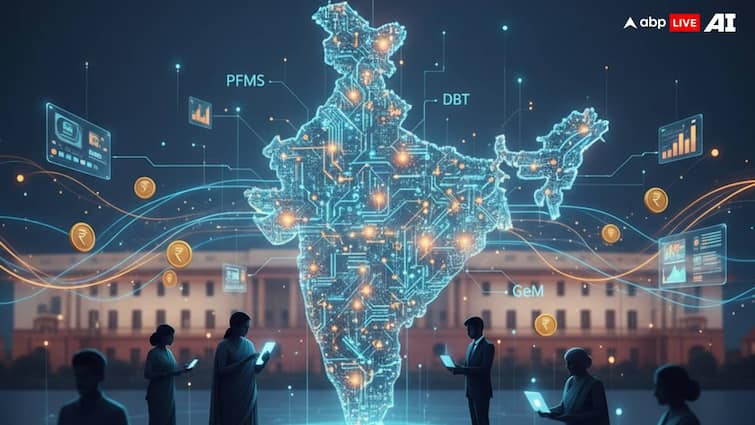Transparent public spending is extremely important because it increases accountability, reduces corruption, thereby reducing misuse of funds and increases public confidence. Therefore, over the last decade and a half, India has made rapid progress in transparency, accountability and efficiency in public expenditure through the integration of technology into governance systems.
The government has taken up digitisation initiatives for better transparency in its work.
The initiatives towards digitalisation have not only modernised the state’s financial functions but also freed up substantial fiscal resources. These resources are now being redirected towards growth-oriented investments in infrastructure, innovation and human capital.
India has been making efforts to reduce wastage of funds, ensure last-mile delivery of welfare benefits and increase cost-effectiveness in government procurement, especially through the Public Financial Management (PFMS), Direct Benefit Transfer (DBT) framework and Government e-Marketplace (GeM).
PFMS & DBT: Direct Benefits, No Hassles
Public Financial Management (PFMS) – a web-based software, was launched in 2009 to enable fund tracking and real-time reporting of expenditure for all plan schemes. PFMS ensures direct and timely transfer of benefits to the bank accounts of beneficiaries, thereby reducing delays and leakages.
Later, Direct Benefit Transfer or DBT was introduced on January 1, 2013, and PFMS was chosen as the common platform to bring about a change in the system of transfer of cash subsidies and benefits. Subsequently, on April 1, 2015, the government made it mandatory for all ministries to use PFMS for DBT. The DBT framework has fundamentally changed the way subsidies and welfare benefits are delivered to the vulnerable sections.
This system minimises leakages, eliminates middlemen, and promotes fiscal discipline by directly depositing funds into the bank accounts of beneficiaries. According to ET Government, as of April 2025, the DBT system has cumulatively disbursed Rs 43.35 lakh crore through PFMS, which includes major welfare, livelihood and subsidy schemes of the central and state governments. In FY25 alone, subsidies worth over Rs 6.6 trillion were provided through DBT, indicating the scale of digital financial inclusion.
According to a report published in the Financial Express, the cumulative savings of the central government since the financial year 2014-15 till date due to removal of fake, duplicate, and non-existent beneficiaries and plugging of subsidy leakages in key welfare schemes has been approximately Rs 4.31 trillion. It is interesting to note here that the elimination of 58.7 million fake ration cards under the Public Distribution System resulted in savings of Rs 2.5 lakh crore, which is about 58 per cent of the total savings so far.
In FY24 alone, the government saved approximately Rs 0.83 trillion. This is increasing fiscal space for targeted spending. It is important to note that the cumulative savings to date are more than double the Rs 2 trillion allocated for production-linked incentive (PLI) schemes for 14 sectors over ten years to 2030 to boost private investment and manufacturing. These figures reflect the extent of fiscal savings achieved by the government through better targeting and elimination of inefficiencies. Due to this, subsidy allocation by the government has reduced from 16 per cent to 9 per cent of total government expenditure.
The government transferred Rs 0.37 trillion to 16.01 crore beneficiaries under central and state schemes using PFMS during the Covid-19 lockdown (March 24 – April 17, 2020). This ensured prompt financial assistance during the crisis. PFMS and DBT ensured quick financial assistance during the crisis, according to CNN News18.
The integration of Aadhaar with bank accounts has further strengthened the credibility of the system by preventing fake beneficiaries and ensuring that funds reach the genuine beneficiaries. The combination of PFMS and DBT have created one of the most streamlined welfare delivery mechanisms, exemplifying how technology can ensure social equity while conserving public resources.
GeM: Revolutionising Public Procurement
If DBT represents efficiency in cash transfers to citizens, the Government e-Marketplace (GeM) is an effective model for transparent and cost-effective public procurement. It was introduced on August 9, 2016, to enhance efficiency, reduce costs and provide a level playing field for all sellers, including startups, women entrepreneurs and MSMEs.
GeM completed its ninth year with record procurement of Rs 5.42 trillion in FY 2024-25 and emerged as one of the largest public e-procurement platforms in the world. It aims to increase its annual turnover to Rs 7 trillion in the current financial year. Since its launch, GeM has become a unified online platform for government procurement, ranging from stationery and services to heavy machinery and IT infrastructure.
To date, total procurement through GeM has exceeded Rs 14.81 trillion through over 3 crore orders since inception, as reported in the Outlook Business. This has resulted in total savings of over Rs 0.45 trillion, reflecting deep institutional adoption across ministries and public agencies. The main attraction of this plan is its cost-saving benefits.
A World Bank evaluation cited in the Hindustan Times found that procurement through GeM results in an average cost savings of 9.75 per cent on the median price compared to traditional procurement methods. This has resulted in huge savings of an estimated Rs 1.15 trillion in public procurement.
Additionally, features like reverse auctions, product aggregation and competitive bidding resulted in savings ranging from 33 per cent to 96 per cent in some categories. These gains reflect not only fiscal prudence but also a structural shift toward evidence-based, data-driven procurement practices.
GeM has made access easier for smaller suppliers. In the last financial year, micro and small enterprises (MSEs) accounted for 36.83 per cent of the total procurement value, well above the mandated 25 per cent limit. By mid-2023, over 6.5 million sellers and 70,000 government buyers have registered on the platform, demonstrating broad participation and inclusivity.
Automation, real-time tracking and end-to-end digitisation have significantly reduced procurement cycle times and transaction costs. This scheme is empowering small and medium enterprises, as now vendor charges are zero or minimal in many categories.
Moreover, the transparency of the platform has greatly reduced the scope for corruption as every bid, order, and delivery can now be tracked.
Fiscal Implication: More Value For Every Rupee
The convergence of PFMS, DBT and GeM has enhanced India's fiscal management framework by combining digital efficiency with financial integrity. The initiative has created fiscal space of over Rs 4 trillion, i.e. 1.33 per cent of the revised estimated GDP for FY 2024-25. This has enabled redistribution of funds to infrastructure, health, education, and innovation without increasing the deficit.
Procurement efficiency through GeM ensures that more goods and services can be made available within the same government budget, thereby enhancing public value creation. Efficient and reliable transfers foster greater trust among citizens in public institutions and increase the overall effectiveness of government programmes.
At a time of fiscal prudence and rising capital expenditure requirements for growth, these efficiency gains reflect a fundamental change in the approach to governance, which goes far beyond mere technological advancements.
Smart Governance: Future Is Now
India’s journey with PFMS, DBT and GeM shows that fiscal efficiency and inclusion can complement each other. The government has created transparent, scalable and citizen-centric systems by leveraging digital technologies. The long-term benefits are clear: better targeting of subsidies, higher fiscal savings, more efficient procurement, and increased public confidence.
As India strides towards its Viksit Bharat 2047 vision, it will be important to strengthen these platforms, PFMS, DBT, GeM, and link their savings to investments in infrastructure, human capital and innovation. In conclusion, optimising expenditure through systems like PFMS, DBT, and GeM is not just good fiscal management – it is the cornerstone of good governance and sustainable economic growth.
(The author teaches finance at the Institute of Technology and Science, Ghaziabad)
Disclaimer: The opinions, beliefs, and views expressed by the various authors and forum participants on this website are personal and do not reflect the opinions, beliefs, and views of ABP Network Pvt. Ltd.



